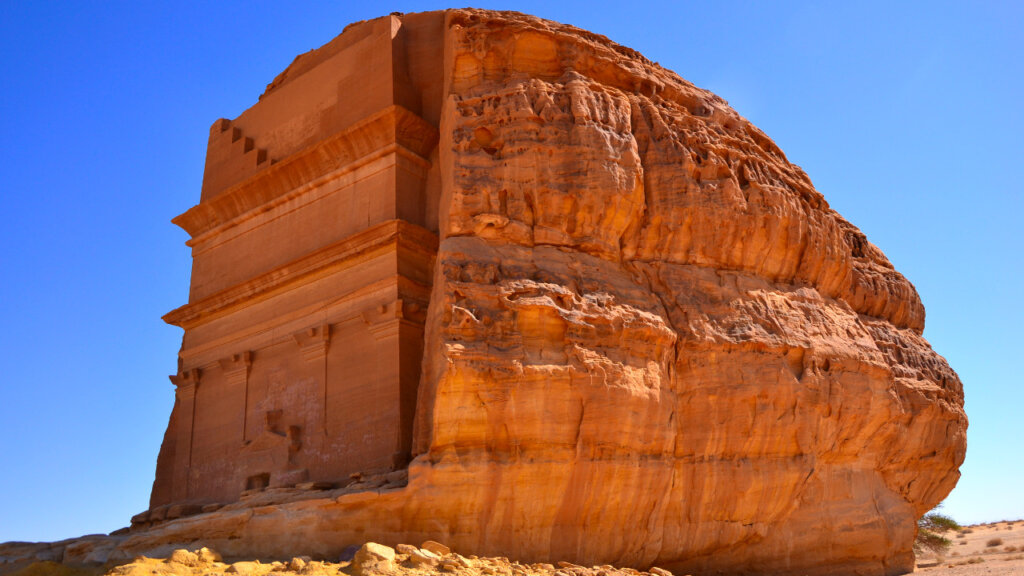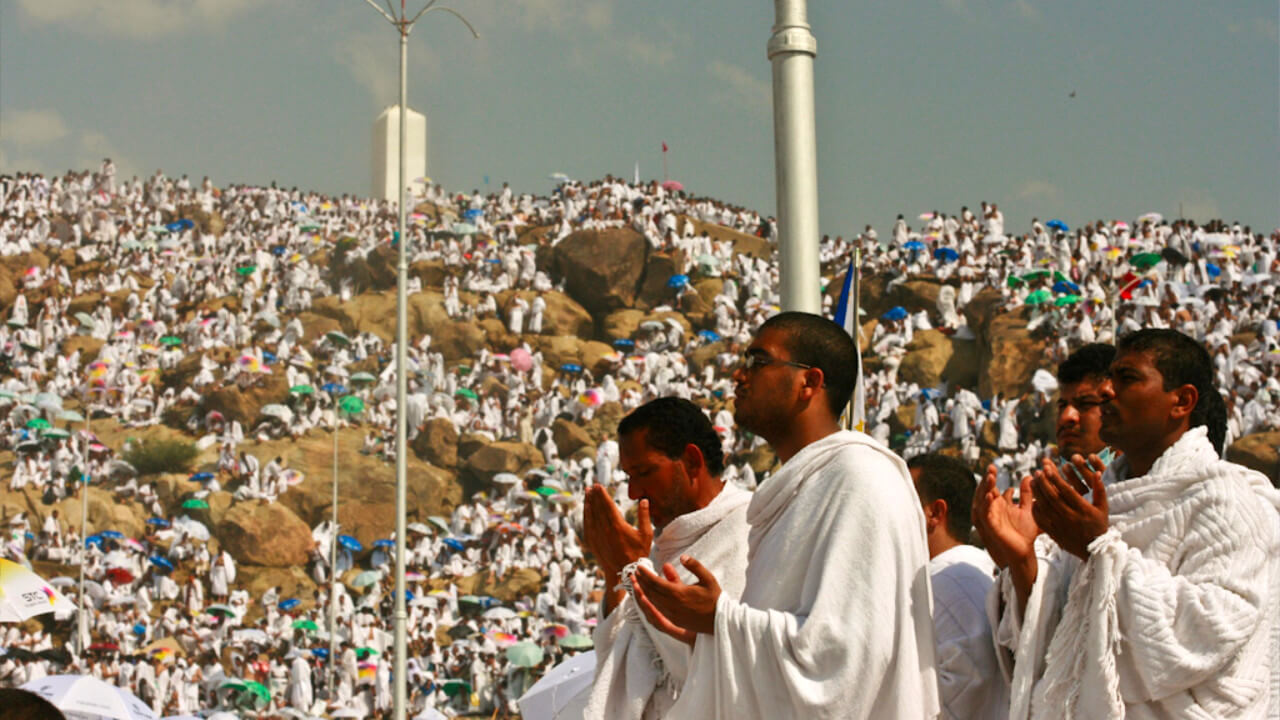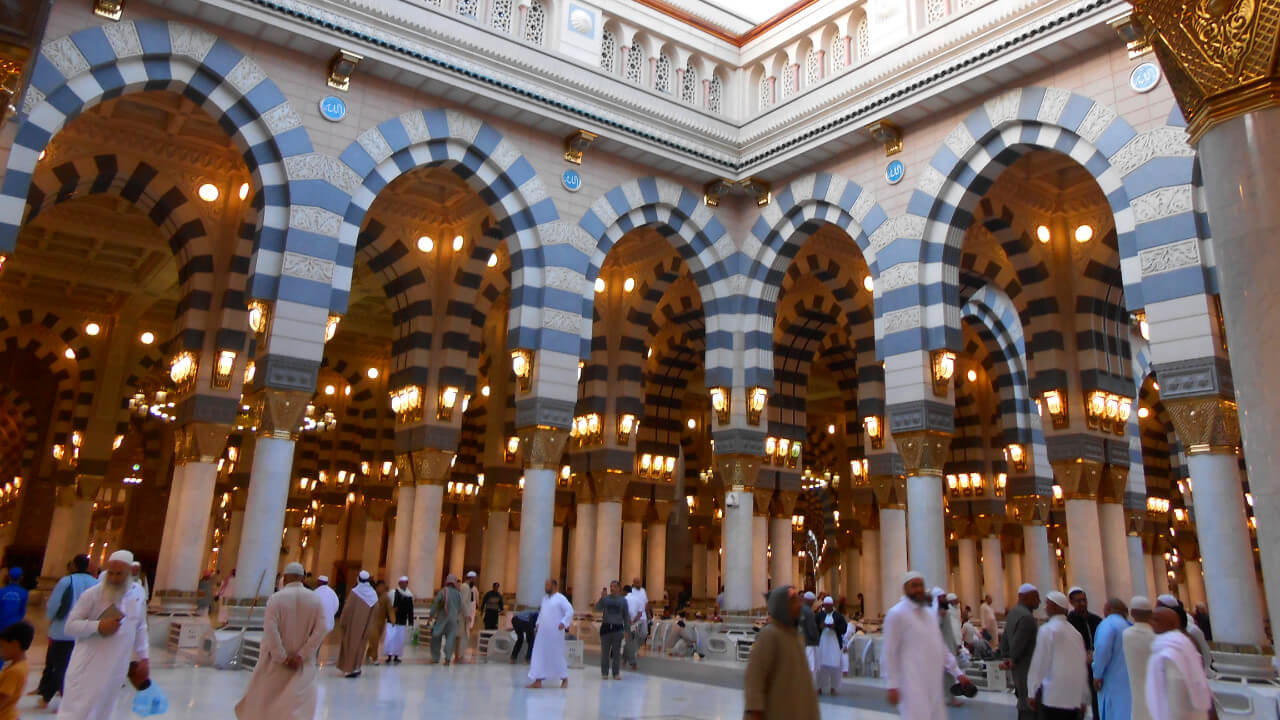
Saudi Arabia is a particularly important country for Muslims worldwide. Firstly, it is home to Mecca and Medina, the two holiest cities of Islam. Secondly, even the tomb of the Prophet Muhammad as well as Kaaba are located in Saudi Arabia. Therefore, Islam has defined the burial practices and customs of Saudi Arabians for over a thousand of years. This article covers all these topics but does not stop there. We also discuss pre-Islamic burials within modern-day Saudi Arabian borders such as rock-cut tombs. Finally, we discuss the movement of Wahhabism and how it has even affected Royal Saudi funerals.
Locals of the Arabian peninsula practiced burials for hundreds, if not thousands, of years prior to the spread of Islam. A prime example of that is the rock-cut tombs of the Nabataeans. First of all, rock-cut tombs require a large rock formation. People then carve a burial chamber, quite literally cutting into the rock. Cliffs make ideal spots for rock-cut tombs since the surface of the formation is then inclining in a perfect angle. For instance, Petra in Jordan follows this pattern.

The Nabataeans were not active, though, only in Jordan. They also established settlements in the northern regions of modern-day Saudi Arabia (ca. 1 Century AD). As a result, rock-cut tombs are found in Saudi Arabia too. The best example of that is Hegra, or Al-Hijr, Saudi Arabia’s first UNESCO World Heritage site. According to the Quran, the site was in the hands of the Thamudi people at a later stage. Moreover, Islamic tradition describes these people worshiping false idols. As a supposed result of that, Hegra experienced multiple lightning storms and earthquakes. In any case, the Hegra burial site earned a reputation as a cursed place – an idea that lasts even in modern times.
Despite multiple plundering attempts, many ancient bodies and grave offerings have survived. Moreover, explorers and researchers have found many of these bodies in a very good state. This preservation is due to the desert climate of the region. Interestingly archeologists support that Nabataeans buried their dead naked, just wearing a necklace made out of dates. They then engulfed the body in leather shrouds. Finally, sacrifices was also a death practice of the Nabataeans. That mostly referred to animal offerings but included human sacrifice too. For instance, a boy was also sacrificed in Dumat Al-Jandal in the Al Jawf Province of modern-day Saudi Arabia.

Nabataean influences are just a ghost of the distant past in contemporary Saudi Arabia. Instead, Islam has spread and extended into almost all aspects of human activity in Saudi Arabia. After all, Islam is the state religion of the country. Furthermore anyone trying to receive the Saudi Arabian nationality has to convert to it. Unsurprisingly, Islamic traditions dictate burial customs too. However, the Quran says very little about how funerals should take place. It is, instead, two other factors that define burial practices in Saudi Arabia: hadith, which refers to traditions and ijtihad, meaning religious reasoning. Furthermore, it was during the 13th and 14th centuries that customs from these sources were written into actual funerary manuals.
As a result of these manuals, most Islamic funerals in Saudi Arabia share many common traits. Firstly, relatives of the same sex as the deceased have to wash the body. This also prepares the deceased for burial. Additionally, relatives have to bury the deceased before the night falls on the same day of their passing. If, however, the person died in the evening or nighttime the funeral has to take place before sunrise.
Occasionally the body is placed in a coffin in order for the relatives to transfer it with ease to the cemetery. As the procession arrives at the cemetery, they take the body out of the coffin so it can be used again. In most cases, though, funerals in Saudi Arabia – just like other Muslim countries – do not use a coffin. Instead, they wrap the body in a burial shroud.

It is also common knowledge that the head of the deceased should be facing Mecca. This is referring to the Qibla axis, which the same principle that Muslim use when praying. An important characteristic is that every burial spot is always large enough for one person.
Therefore, even if many graves are next to each, two bodies are almost never buried together. That applies also to married individuals. Finally, in most cases cemeteries are at the outskirts of cities and visiting the graves is discouraged. However, this is not necessarily the case for certain cemeteries and graves in Saudi Arabia’s two holiest cities: Mecca and Medina.
According to most sources, Mecca is the birthplace of the Prophet Muhammad. In addition to that, it was next to the city and specifically at the Jabal al-Nur (“Mountain of Light”) that the Quran was presented to Muhammad. As a result, Mecca holds incredible significance to Muslims not only in Saudi Arabia but worldwide. For instance, pilgrimage for the Hajj, is obligatory for all Muslims that are able to do it at least once in their life.

The most important Islamic element of Mecca is the magnificent Al-Masjid al-Haram – or Great Mosque. This also is the largest Mosque in the world but more importantly it’s home to Kaaba. The Kaaba also spelled Ka’bah, is the iconic black structure that lies in the heart of the Great Mosque. All of the grandeur of these structures creates a stark difference with the nearby cemetery of Jannat al-Mu’alla. Literally translating to the Most Exalted Paradise, the cemetery is located just north of the Great Mosque. It is also the resting place of Prophet Muhammad’s wife but also grandfather and other relatives.
The Prophet himself, though, is buried in Medina, the second holiest city of Islam. Moreover, the Jannat al-Baqi’ cemetery of Medina was destroyed in 1925 under the then King of Saudi Arabia, Ibn Saud. The demolition of these burial sites has been dubbed as the Day of Sorrow, due to the significance of these graves. We will return to the topic of grave destruction later, but we are next focusing on the burial site of the Prophet himself.

Prophet Muhammad’s body is buried in the Sacred Chamber at the Al-Masjid an-Nabawi Mosque. Also known as the Prophet’s Mosque, the site is also famous for its enormous Green Dome. Additionally, there are two more people buried in the same room as the Prophet – his two closest friends: Abu Bakr al-Siddiq and Umar ibn al-Khattab.
Originally, the Sacred Chamber was the home of Muhammad’s wife, Aisha. Nowadays though, the Sacred Chamber is a crucial component of the Masjid Nabawi and it is completely closed off and has no windows. There also is a particularly interesting potential explanation for this.
According to stories, there have been some attempts to steal the remains of the Prophet. The most interesting of these, is perhaps the one of 1164 CE. According to Islamic stories, two Christian men from Rome disguised themselves as Muslim pilgrims. They had apparently learned Arabic and Islamic customs and managed to fool everyone. Therefore, they stayed in Medina for almost a year, actually building a tunnel from their home to the Prophet’s grave. As the story goes, the truth was revealed to a Sultan who managed to arrest the men before they managed to complete their mission.
After interrogating them, he executed the men and built a trench with molten lead so that no one will attempt that again.
We mentioned above the 1925 destruction of multiple graves – known as the Day of Sorrow. Why, though, did the King of Saudi Arabia order this?
The answer to this question is linked to the Wahhabi-Salafi movement. This tradition of the Sunni school of Islam has the strictest approach, interpreting the Quran literally. Saudi Arabian scholars have followed this for a couple of centuries already, making Salafism the official school of thought in Saudi Arabia’s theocracy. Moreover, the Quran preaches monotheism and devotion to the one true God. As a result, worshiping anything – or anyone – else is strictly forbidden in Wahhabism. This also included every mosque, dome containing a grave.
The idea was that graves could end up being worshiped by relatives which, consequently could lead to idolatry. All religious sites containing graves were demolished but they were not the only ones.
Certain graves had to be demolished, according to Wahhabism, out of fear of tempting people to venerate them. And that included some graves of the Prophet’s ancestors in Medina – thus destroyed in 1925. In addition to the above, there is another great example of how the Salafi movement has influenced burial practices. We are talking about no other than the burials of Saudi Arabian royals themselves.

Wahhabism also preaches simplicity and austerity – including funerals. Therefore, although the Saudi royalty may live a luxurious life, their death is much simpler. That was also the case for the late King of Saudi Arabia, Fahd. He passed away on August first 2005 but there was virtually no mourning period for his Kingdom. That is also a result of Wahhabism, since public grieving is frowned upon.
The best example of the extent of influence of Wahhabi austerity and conservatism was the King’s burial: He was wrapped in a common shroud and placed in a simple, unmarked grave just like his predecessors. Moreover, his burial spot was no other than Riyadh’s Oud public cemetery. That means that royalty and commoners are all buried in the same cemetery, including Saudi Arabia’s first modern king, Abdulaziz bin Abdul Rahman Al Saud – known also as Ibn Saud.

We hope you learned something new regarding this country’s death practices!
Did you like learning more about the tomb of the Prophet? Or maybe you want know more about funeral practices of other Gulf countries. Then feel free to check out our Oman article! For funerary details about other predominantly Muslim countries have a look at our articles on Egypt and Iran.
The average mixed death rate of Saudi Arabia is 3,505 per 1.000 people (2019).
According to Islamic tradition, Saudi Arabians bury their dead within 24 hours after death. If the deceased has passed away after sunset, most funerals take place before sunrise.
We have already mentioned that Saudi Arabia is an Islamic theocracy. The significance of Islam for Saudi Arabians is profound, especially if we keep in mind that the Mecca and Medina, the two holiest cities of Islam are within Saudi boarders. Moreover, Saudi Arabia officially follows the Sunni and specifically the Hanbali school of thought. As a result, 90% of Saudi Arabians are Sunni Muslims and the rest are Shia. Sunni and Shia are the only schools of Islam recognized by the Saudi Arabian government.
Furthermore, 30% of the population of Saudi Arabia is actually foreigners. Although most are Muslim too, other religions such as Christianity are present too. Saudi Arabia has been criticized by international organizations for a lack of religious freedom. Finally, being an atheist is illegal in Saudi Arabia, punished as a capital offense.
According to the SCOT, the Saudi Center for Organ Transplantation, the rate of utilized organs in 2020 was 1,89 per million population. That corresponds to 63 transplants in that year.